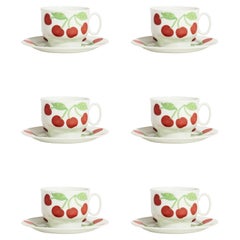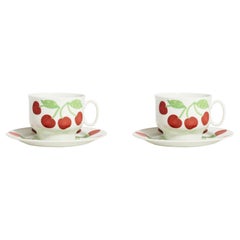Ginori Cherries
Recent Sales
Vintage 1950s Italian Tea Sets
Porcelain
Vintage 1950s Tea Sets
Porcelain
Mid-20th Century Italian Mid-Century Modern Porcelain
Porcelain
Richard Ginori for sale on 1stDibs
The striking elegance and craftsmanship associated with vintage Richard Ginori porcelain and ceramics are hallmarks of the distinguished Italian manufacturer's deep heritage. Over nearly 300 years, the company has established a legacy of enduring design — its exquisite handmade serving pieces, tea sets, tableware, vases and more are coveted all over the world.
Richard Ginori traces its long history back to the village of Doccia, Italy, where marchese Carlo Ginori opened the Doccia Porcelain Manufactory in 1735. The factory employed talented Viennese painters and modelers, and although it took time for Carlo to perfect his models and molds, the company eventually became known for its impeccable white porcelain, inspired by Ginori's love of white gold. By 1779, the factory’s refined porcelain decorated palaces and stately residences.
In 1896, the factory expanded and merged with the Società Ceramic Richard of Milan. The new company was named Richard Ginori, and the early 20th century marked a period of artistic revival for the manufacturer.
In 1923, the influential Italian architect, publisher and furniture designer Gio Ponti was appointed as the company's artistic director (a role he held until 1933). He was still a young man at the time, but the now-celebrated polymath was fearless in his efforts to innovate at Richard Ginori — he introduced a contemporary spirit at the manufacturer and integrated ancient Roman art and other neoclassical elements into his richly ornate designs for decorative objects and ceramic vessels. At the 1925 International Exhibition of Modern Decorative and Industrial Arts in Paris — the design fair that brought the Art Deco style into the world — both Richard Ginori and its bold artistic director won a Grand Prix.
In the decades that followed, offerings at the storied porcelain manufacturer showed an adoption of the modern style that had taken shape in furniture design and decorative arts during the mid-20th century. In 1954, the company was renamed Ginori 1735, a reference to its inaugural year. Over time, Richard Ginori has partnered with numerous renowned designers such as Giovanni Gariboldi, Antonio Piva, Franco Albini and Aldo Rossi. In 2013, Gucci purchased the Ginori 1735 brand and factory.
On 1stDibs, find a collection of vintage Richard Ginori serveware and decorative objects.
Finding the Right Porcelain for You
Today you’re likely to bring out your antique and vintage porcelain in order to dress up your dining table for a special meal.
Porcelain, a durable and nonporous kind of pottery made from clay and stone, was first made in China and spread across the world owing to the trade routes to the Far East established by Dutch and Portuguese merchants. Given its origin, English speakers called porcelain “fine china,” an expression you still might hear today. "Fine" indeed — for over a thousand years, it has been a highly sought-after material.
Meissen Porcelain, one of the first factories to create real porcelain outside Asia, popularized figurine centerpieces during the 18th century in Germany, while works by Capodimonte, a porcelain factory in Italy, are synonymous with flowers and notoriously hard to come by. Modern porcelain houses such as Maison Fragile of Limoges, France — long a hub of private porcelain manufacturing — keep the city’s long tradition alive while collaborating with venturesome contemporary artists such as illustrator Jean-Michel Tixier.
Porcelain is not totally clumsy-guest-proof, but it is surprisingly durable and easy to clean. Its low permeability and hardness have rendered porcelain wares a staple in kitchens and dining rooms as well as a common material for bathroom sinks and dental veneers. While it is tempting to store your porcelain behind closed glass cabinet doors and reserve it only for display, your porcelain dinner plates and serving platters can safely weather the “dangers” of the dining room and be used during meals.
Add different textures and colors to your table with dinner plates and pitchers of ceramic and silver or a porcelain lidded tureen, a serving dish with side handles that is often used for soups. Although porcelain and ceramic are both made in a kiln, porcelain is made with more refined clay and is stronger than ceramic because it is denser.
On 1stDibs, browse an expansive collection of antique and vintage porcelain made in a variety of styles, including Regency, Scandinavian modern and other examples produced during the mid-century era, plus Rococo, which found its inspiration in nature and saw potters crafting animal figurines and integrating organic motifs such as floral patterns in their work.

